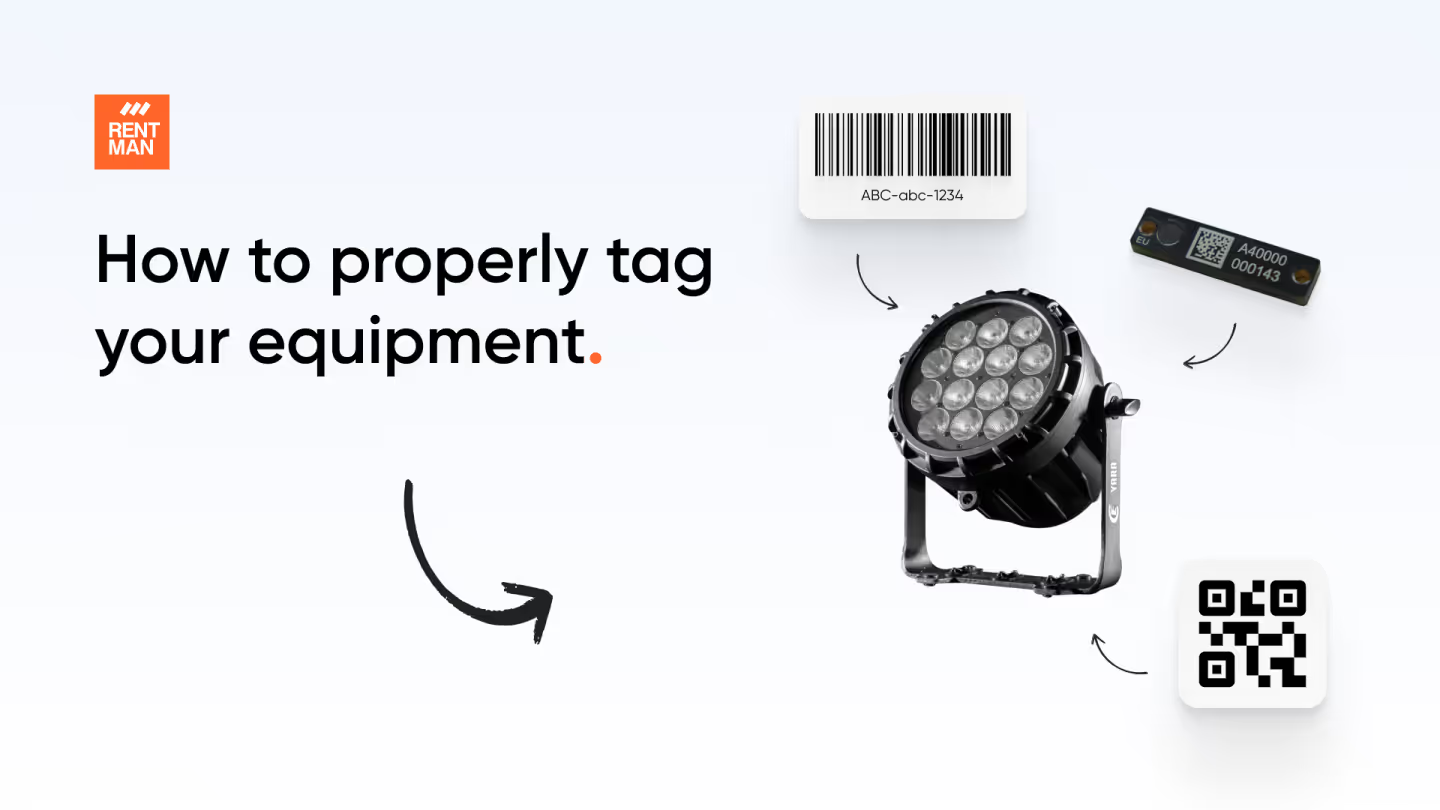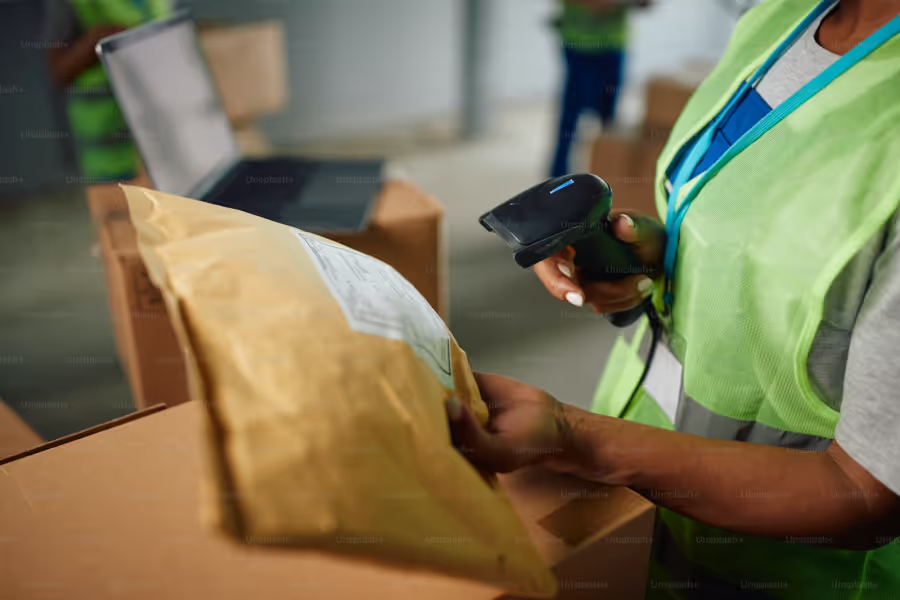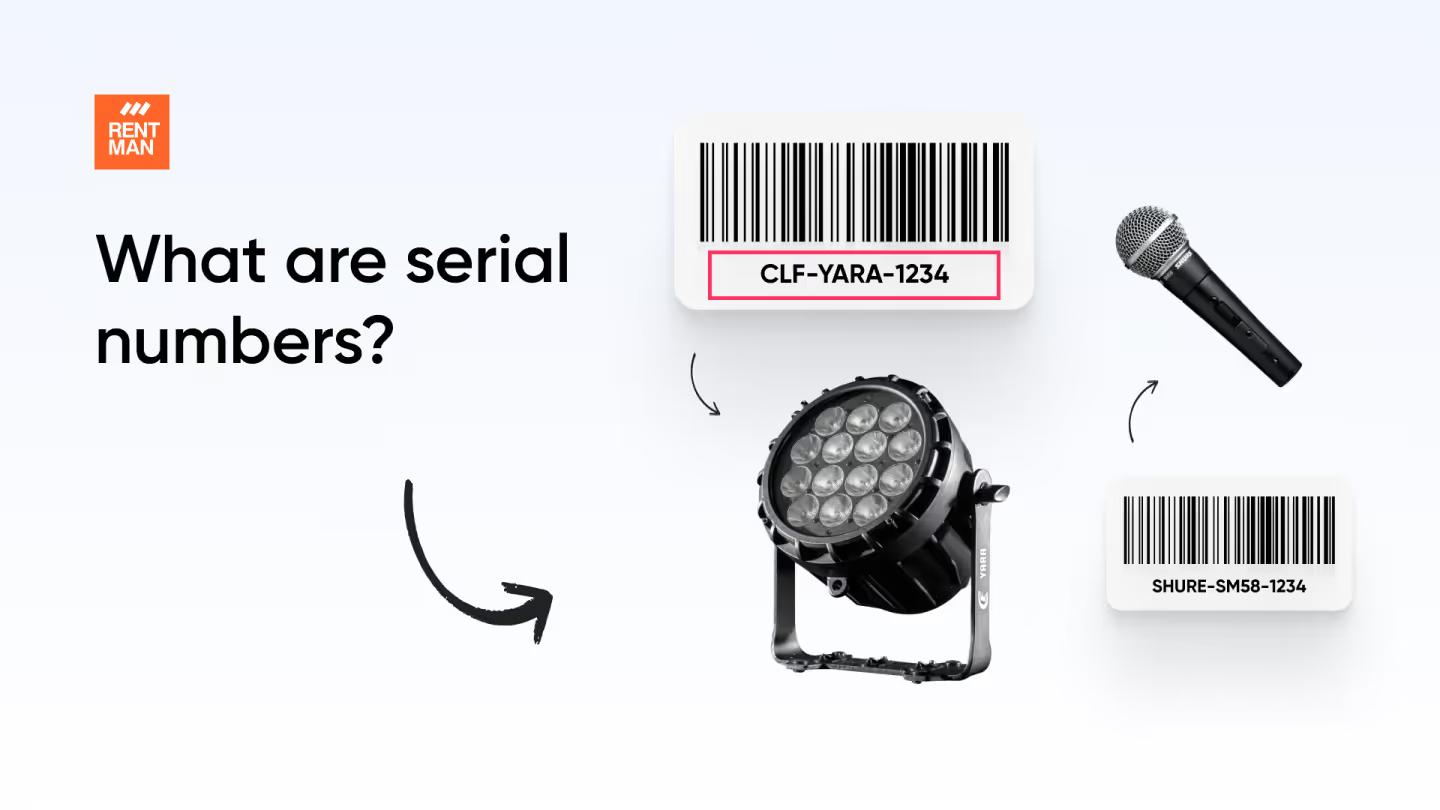How to set Asset Tags for your Equipment: A Comprehensive Guide for Rental Businesses

Managing a diverse inventory across multiple locations can be a logistical labyrinth: have you ever tried keeping track of a large order, perhaps even spread across the country?
If so, you know that losing oversight of orders can happen in the blink of an eye.
This problem is all too familiar for rental business owners, who are managing equipment and crew over various places and schedules. However, amidst this chaos, a simple yet powerful solution emerges: asset tags.
In this comprehensive guide, we'll walk you through the ins and outs of asset tags for equipment, from understanding its basics to implementing them seamlessly in your business.
1. What is an asset tag?
2. Why you need asset tags
3. Different types of asset tags
4. A step-by-step guide to asset tagging
5. How Rentman can help
What are asset tags?
Let's start with the basics. Asset tagging is the process of attaching tags or labels to assets. You can view these tags as name tags for your products that enable you to monitor the products in real-time, forming the backbone of an efficient asset tagging system for your business.
These asset tags come in various shapes and sizes, each designed to cater to specific needs. They can be as simple as stickers or as sophisticated as electronic devices, depending on your requirements!
You may ask yourself now: why would I invest my time and money in such a seemingly simple solution?

Why you need asset tags
Asset tagging goes beyond just labeling your equipment for identification purposes. Depending on your chosen method, you can keep a constant eye on the location and know the status of your valuable assets in real-time.
Here are 4 compelling reasons why we think asset tags are an absolute must for your rental business:
Inventory Control
Inventorying can be a daunting task, due to its time-consuming, labor-intensive nature, high potential for errors, lack of visibility, complex warehouse layouts, and various types of movable assets.
With the benefits of asset tagging you can say goodbye to this type of chaotic warehouse management. Asset tagging simplifies the inventoryprocess, by providing unique identifiers for each asset, which eliminates the need for manual counting and tracking. This not only enhances the efficiency of your inventory control but also ensures high accuracy.
Theft Prevention
Tamper-evident asset tags make it obvious if someone has tried to remove the metal asset tags, which can raise suspicion and make it less likely that a stolen asset will be accepted for sale.
Moreover, unique identification codes of asset tags can be used to track lost or stolen equipment and assets online, making it easier for law enforcement and pawn shops to identify and recover them.
Asset tags also reduce the motivation to steal by making the moveable assets make it clear that the property is tracked and traceable.
Maintenance History Tracking
Asset labels provide important information for maintenance staff, offering a quick and clear way to access details like maintenance schedules and equipment history, which leads to proactive maintenance and minimizing downtime. This ensures timely servicing of assets, prolonging their lifespan and minimizing unexpected breakdowns.
Improved Customer Service
To summarize, asset tags create better, streamlined operations, optimize asset utilization, increase asset visibility, enhance communication and deter theft. These improvements lead to faster service delivery, uninterrupted equipment performance, and more informed customer service - which all boost customer satisfaction!
So now that you know why to invest in asset tagging, let's see which type of asset tags to choose based on your business.
Different types of asset tags
Let's uncover the three main types of asset tags we recommend rental business owners to consider:
Barcode Tags
Easy to apply and scan, barcode tags are ideal for tracking smaller items like tools, electronics, and small appliances. They are typically printed with a unique asset ID number that is linked to the asset's information in a centralized inventory management system.
When to choose Barcode Tags:
→ When cost is a major factor, as barcode tags are the most affordable option.
→ When assets are frequently handled and require frequent scanning.
→ When simple, asset tracking software is sufficient, because barcodes do not store extensive data.
QR Code Tags
Quick Response (QR) codes are a versatile alternative to barcode tags that can be scanned using smartphones or tablets. They are becoming increasingly popular due to their widespread compatibility with mobile devices and because they are able to store more data compared to barcodes - making them suitable for storing detailed asset information.
When to choose QR code tags:
→ When it is crucial to store detailed asset information
→ When mobile device compatibility is essential
→ When compatibility with widespread mobile devices is desired, as QR codes are widely supported by mobile operating systems.
Read all about the differences between QR codes and barcodes and when to use these asset tags.
RFID Tags
Embedded with microchips that store digital information and can be read wirelessly using RFID (Radio Frequency Identification) readers, this type of asset tracking tag offers a more advanced and versatile solution.
When to choose RFID tags:
→ When tracking large physical assets like vehicles, generators, and construction equipment.
→ When real-time asset tracking or access control is required, because RFID tags can provide immediate asset identification.
→ When the need for contactless asset identification and inventory management is high, as RFID tags can be read without direct contact.
Our comprehensive guide to RFID tracking will get you started with this time- and money saver.
Know which type of asset tag you want to use for your business? Then continue reading and get the asset tag up and running!

Step-by-step guide to asset tagging
We've broken down the process of asset tagging into manageable steps:
1. Identify Asset Type and Category
Before you start assigning unique identifiers and attaching tags, you need to clearly understand the type and category of each asset. For example, if you rent out both birthday accessories and camera equipment, you need to classify them appropriately as "party rental" and "photographic equipment" to ensure your asset management system addresses them accordingly.
This step is essential for developing an effective asset tracking system that caters to the specific needs of your organization.
Consider these questions:
- What is the primary function of the asset?
- What is its physical size and shape?
- What environment does the asset operate in?
- Is the asset prone to theft or damage?
2. Assign a Unique ID Number
Each asset should have a unique identifier that distinguishes it from other assets. This unique ID number is the backbone of the asset tagging process, enabling you to track, manage, and locate assets efficiently.
Best practices for assigning unique IDs:
- Use a consistent and standardized format for asset IDs.
- Ensure that the IDs are readily visible and easily scannable.
- Avoid using easily guessable numbers or sequences by opting for a barcode or QR code. This also enhances the readability.
3. Choose the Appropriate Tag Type
Not all assets are created equal, and neither are the tags that accompany them. Select a tag type that aligns with the asset's environment and specific requirements. For this, consult the different types of asset tags.
4. Enter Asset and Associated Information
Comprehensive asset information is best managed using asset tagging software, which allows you to centralize all data, ensuring real-time visibility and streamlined operations.
Essential information you need to enter in your asset management tool to provide full oversight:
- Asset identification number
- Serial or model numbers
- Location of the warehouse
- Information about the manufacturer or vendor
- The date of asset acquisition
- Status of the asset
- Value of the asset
5. Implement Data Verification Processes
To ensure the ongoing accuracy of your asset information, establish regular verification and update processes. This proactive approach prevents discrepancies and maintains your asset tracking system:
- Regularly review and update asset information to ensure accuracy.
- Implement automated data verification tools or processes.
- Conduct spot checks and audits to identify discrepancies.
- Establish clear procedures for handling discrepancies and updating records.
Still overwhelmed by all this information? Rentman's got your back. Learn how to organize your rental business with asset tags.
Always know where your assets are with Rentman
Managing a rental business can be challenging, especially during peak seasons when demands are high. At Rentman, we understand how frustrating it can be to lose track of equipment as soon as it leaves your warehouse. And that's why we developed our Warehouse module.
Rentman helps simplify operations by offering digital packing slips and QR code scanning, which significantly reduce packing mistakes and allow for real-time equipment tracking. Our user-friendly Warehouse module keeps all project information organized, making it easier for your team to collaborate and adapt to changes on the fly.
Plus, Rentman addresses the common issue of communication breakdowns. By centralizing information, it ensures that all team members are on the same page regarding deadlines, equipment availability, and last-minute changes. This clarity reduces confusion and keeps productions running smoothly.
With tools designed for both experienced staff and new freelancers, onboarding becomes straightforward. By improving efficiency, accountability, and communication, Rentman helps warehouse managers provide better service to clients, while also managing their stress load. Discover how our solutions can make your daily operations smoother and more effective, ultimately enhancing your overall business performance.
Take control with Rentman today!
FAQ
Frequently asked questions
No items found.
Previous blog posts

How a serial number works and why you should use it
How a serial number works and why you should use it


